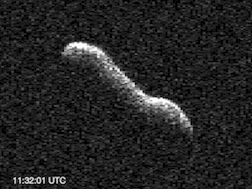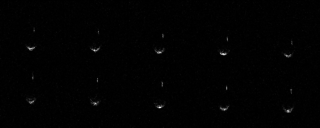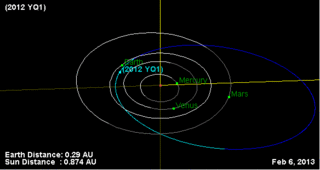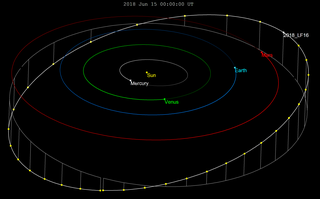The Torino scale is a method for categorizing the impact hazard associated with near-Earth objects (NEOs) such as asteroids and comets. It is intended as a communication tool for astronomers and the public to assess the seriousness of collision predictions, by combining probability statistics and known kinetic damage potentials into a single threat value. The Palermo Technical Impact Hazard Scale is a similar, but more complex scale.
(143649) 2003 QQ47, provisionally designated: 2003 QQ47, is a kilometer-sized asteroid and synchronous binary system, classified as near-Earth object and potentially hazardous asteroid of the Apollo group. It became briefly notable upon its discovery in late August 2003, when media outlets played up a very preliminary report that it had a 1 in 250,000 chance of impacting into Earth on 21 March 2014. The discovery of a companion, approximately 310 meters (1,000 ft) in diameter, was announced in September 2021.
(433953) 1997 XR2 is a sub-kilometer sized asteroid, classified as near-Earth object and potentially hazardous asteroid of the Apollo group. It was discovered on 4 December 1997, by the Lincoln Near-Earth Asteroid Research (LINEAR) program at Lincoln Laboratory's Experimental Test Site near Socorro, New Mexico, in the United States.
99942 Apophis (provisional designation 2004 MN4) is a near-Earth asteroid and a potentially hazardous object, 450 metres (1,480 ft) by 170 metres (560 ft) in size, that caused a brief period of concern in December 2004 when initial observations indicated a probability of 2.7% that it would hit Earth on Friday, 13 April 2029. Additional observations provided improved predictions that eliminated the possibility of an impact on Earth in 2029. A small possibility nevertheless remained that, during its 2029 close encounter with Earth, Apophis would pass through a gravitational keyhole estimated to be 800 metres in diameter, which would have set up a future impact exactly seven years later on Easter Sunday, April 13, 2036. This possibility kept it at Level 1 on the Torino impact hazard scale until August 2006, when the probability that Apophis would pass through the keyhole was determined to be very small and Apophis's rating on the Torino scale was lowered to zero. By 2008, the keyhole had been determined to be less than 1 km wide. During the short time when it had been of greatest concern, Apophis set the record for highest rating ever on the Torino scale, reaching level 4 on December 27, 2004.
(292220) 2006 SU49, provisional designation 2006 SU49, is a sub-kilometer asteroid, classified as near-Earth object and potentially hazardous asteroid of the Apollo group that had a small chance of impacting Earth in 2029.
(481482) 2007 CA19 is a sub-kilometer asteroid, classified as near-Earth object and potentially hazardous asteroid of the Apollo group. It led the impact hazard list, with a Torino Scale impact risk value of 1, for one week, ending on February 19, 2007. Before and after 2007 CA19, 99942 Apophis was the object with the highest Palermo Scale rating. With an observation arc of 4.8 days, it had a Palermo Scale of −0.88.

2007 VK184 is a sub-kilometer asteroid, classified as a near-Earth object of the Apollo group, and estimated to be approximately 130 meters (430 ft) in diameter. It was listed on the Sentry Risk Table with a Torino Scale rating of 1 for a potential impactor in June 2048. It was removed from the Sentry Risk Table on 28 March 2014.

(367789) 2011 AG5, provisional designation 2011 AG5, is a sub-kilometer asteroid, classified as near-Earth object and potentially hazardous asteroid of the Apollo group. It has a diameter of about 140 meters (460 ft). It was removed from the Sentry Risk Table on 21 December 2012 and as such it now has a rating of 0 on the Torino Scale. It was recovered in December 2022 extending the observation arc from 4.8 years to 14 years. As of 2023, the distance between the orbits of Earth and 2011 AG5 is 0.0004 AU (60,000 km; 0.16 LD)

(410777) 2009 FD is a carbonaceous sub-kilometer asteroid and binary system, classified as near-Earth object and potentially hazardous asteroid of the Apollo group, discovered on 24 February 2009 by astronomers of the Spacewatch program at Kitt Peak National Observatory near Tucson, Arizona, in the United States.

(669555) 2012 YQ1 is a sub-kilometer asteroid, classified as a near-Earth object and a potentially hazardous asteroid of the Apollo group, approximately 200 meters in diameter. It was first observed on 19 December 2012, by astronomers Andrey Oreshko and Timur Kryachko at the Elena Remote Observatory (G32) located in the Chilean Atacama desert.
2012 KP24 (also written 2012 KP24) is a Chelyabinsk-sized near-Earth asteroid with an observation arc of only 5 days and has a modestly determined orbit for an object of its size. Around 31 May 2023 ±3 days it will pass between 0.19–24 lunar distances (73,000–9,200,000 km) from Earth. Nominally the asteroid is expected to pass 0.026 AU (3,900,000 km; 10 LD) from Earth and brighten to around apparent magnitude 21.6.
(163132) 2002 CU11, provisional designation 2002 CU11, is a bright, sub-kilometer asteroid, classified as near-Earth object and potentially hazardous asteroid of the Apollo group. Based on absolute magnitude, it is the second largest asteroid known to have passed closer than the Moon.
2013 TV135 is an Apollo near-Earth asteroid estimated to have a diameter of 450 meters (1,480 ft). On 16 September 2013, it passed about 0.0448 AU (6,700,000 km; 4,160,000 mi) from Earth. On 20 September 2013, it came to perihelion (closest approach to the Sun). The asteroid was discovered on 12 October 2013 by Ukrainian amateur astronomer Gennadiy Borisov with a custom 0.2-meter (7.9 in) telescope using images dating back to 8 October 2013. It was rated level 1 on the Torino Scale from 16 October 2013 until JPL solution 26 on 3 November 2013. It reached a Palermo Technical Impact Hazard Scale rating of -0.73. It was removed from the JPL Sentry Risk Table on 8 November 2013 using JPL solution 32 with an observation arc of 27 days.
(177049) 2003 EE16, provisionally known as 2003 EE16, is an Apollo near-Earth asteroid and potentially hazardous object. It was discovered on 8 March 2003 by LPL/Spacewatch II at an apparent magnitude of 20 using a 1.8-meter (71 in) reflecting telescope. It has an estimated diameter of 320 meters (1,050 ft). The asteroid was listed on Sentry Risk Table with a Torino Scale rating of 1 on 2 April 2003.
(415029) 2011 UL21, provisional designation 2011 UL21, is an Apollo class potentially hazardous asteroid discovered on October 17, 2011, by the Catalina Sky Survey project. The asteroid is estimated to have a diameter of 2.5 kilometres (1.6 mi). It was rated at Torino Scale 1 on October 27, 2011, with an observation arc of 9.6 days.

2017 XO2, also written 2017 XO2, is a sub-kilometer asteroid and near-Earth object of the Apollo group approximately 110 meters (360 feet) in diameter. The asteroid was discovered by Pan-STARRS in December 2017, after it already had approached Earth at 0.051 AU (7,600,000 km) or 20 lunar distances (LD) on 6 November 2017. On 26 April 2057, it will pass Earth at a similar distance of 21 LD again.

2018 LF16 is a small Mars crossing asteroid roughly 213 m (699 ft) in diameter. It was first observed by astronomers with the Pan-STARRS survey at Haleakala Observatory on 14 June 2018. It was removed from the Sentry Risk Table on 29 July 2021. With an observation arc of 15 years the orbit is very well known and it does not make any notable approaches to Earth.
2022 AE1 is a Tunguska event-sized asteroid, classified as a near-Earth object of the Apollo group, approximately 70 meters (230 feet) in diameter. It was discovered by the Mount Lemmon Survey on 6 January 2022, when it was 0.09 AU (13 million km) from Earth. On 9 January 2022 with an observation arc of 3 days, it was rated with a Torino scale of 1 for a virtual impactor on 4 July 2023 16:28 UTC. Nominal approach is expected to occur 1 July 2023 01:13 ± 1 day. With a Palermo scale rating of as high as –0.66 at the European Space Agency on 11 January 2022, the odds of impact peaked at about 4.6 times less than the background hazard level. NEODyS was the first risk-page to drop to Torino scale 0 on 12 January 2022 followed by ESA on 13 January 2022, but by January 14 both returned to Torino scale 1. On 14 January 2022 the waxing gibbous moon was as little as 3 degrees from the asteroid delaying observations of the asteroid from January 12–19. On 20 January 2022 with a 16-day observation arc, using JPL #11 the Sentry Risk Table dropped the asteroid to Torino scale 0 and then later that day JPL #12 resulted in it being removed from the risk table.
2023 DW is a near-Earth asteroid of the Aten group. It is approximately 50 meters in diameter, roughly the size of the asteroid that caused the Tunguska event, and was discovered by Georges Attard and Alain Maury, from the MAP (Maury/Attard/Parrott) asteroid search program in San Pedro de Atacama on 26 February 2023, when it was 0.07 AU (10 million km) from Earth. On 28 February 2023, with an observation arc of 1.2 days, it was rated 1 on the Torino scale for a virtual impactor on 14 February 2046 at 21:36 UTC. The nominal approach is expected to occur about eight hours before the impact scenario at 14 February 2046 13:15 ± 72 minutes. Between 5–8 March, the asteroid was not observed as it was within 40 degrees of the waxing gibbous moon. On 14 March 2023 the European Space Agency was the first to drop to a Torino scale rating of 0. Sentry dropped to a Torino scale rating of 0 on 16 March 2023. It was completely removed from both risk tables on 20 March 2023.
2023 GQ2 is an asteroid roughly 400 meters in diameter, classified as a near-Earth object and potentially hazardous object of the Apollo group. It was first discovered on 12 April 2023, when it was 1.3 AU (190 million km) from Earth, with the Bok Telescope at Kitt Peak National Observatory. On 19 April 2023, with an observation arc of 6.7 days, it was rated 1 on the Torino scale for a virtual impactor on 16 November 2028 at 00:58 UTC. When it had a Palermo scale rating of –0.70, the odds of impact were about 5 times less than the background hazard level and this gave the asteroid one of the highest Palermo scale ratings ever issued. On 20 April 2023 precovery images from May 2019 were announced extending the observation arc to 3.9 years, and the 2028 virtual impactor was removed from the Sentry Risk Table. It is now known the nominal approach will safely occur about 13 hours after the impact scenario on 16 November 2028 13:36 ± 40 minutes.







